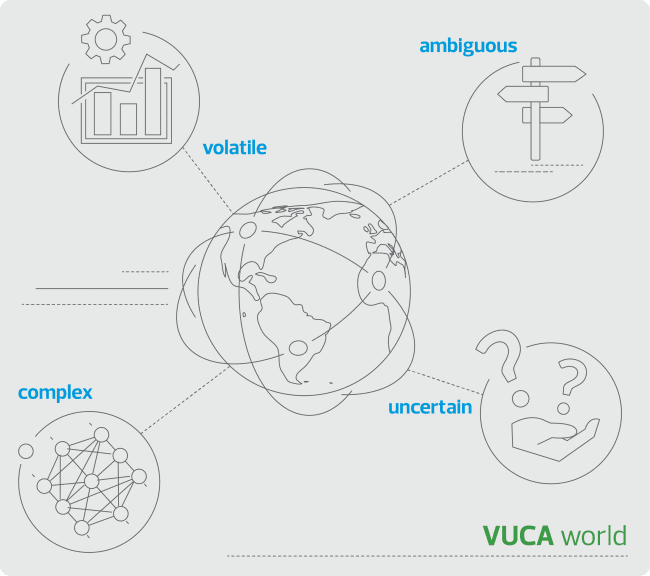We all aspire to be agile – to be able to move quickly and easily, to think and understand rapidly. Who wants to be seen as slow and clumsy?
In the business arena, agility is becoming the 21st century’s most desired attribute. For many companies, embracing some form of agile management is a way to cope with a world that is volatile, uncertain, complex and ambiguous – the so-called VUCA world.
RSM, with a network of audit, tax and consulting experts all over the globe, also endeavour to be agile, while helping clients to adapt with speed to market changes, responding quickly and flexibly to their needs.
The concept of agility has its roots in the ‘Agile Manifesto’ drawn up by 17 software engineers in a ski resort in Utah in 2001. Big information technology projects have long been notorious for being late, costly and delivering unsatisfactory results. The idea was to tackle this by using small, multi-disciplinary teams that would make changes step-by-step, adapting to circumstances as they proceed rather than sticking to a grand plan.
The approach has since been widened to different types of projects along with product development, marketing and other aspects of business. In human resources, ‘agile working’ has come to denote flexibility over when, where and how people work.
Agile management allows cross-functional, largely self-governing teams to test ideas on a small scale, continually adjusting for feedback from customers. Those that fail to work can be abandoned. Teams tackle tasks in short cycles and then move on or are disbanded when they have achieved their immediate goal. A culture of trust and openness must be established.

Companies of all sizes and types are exploring whether their entire business can become agile. Enterprises such as Spotify and Netflix, the music and video streamers, adopted agile models from the start, while established businesses such as online retailer Amazon, engineering firm Bosch and enterprise software supplier SAP, have also embraced the approach. Saab, the Swedish defence company, created more than 100 agile teams, covering software, hardware and the fuselage, to build its Gripen fighter jet.
The appeal of agile management to established companies is clear. The old, hierarchical corporate model epitomised by General Motors and Ford a century ago works less well in today’s rapidly changing environment. An average large company reorganises every two to three years and the reorganisation can take more than 18 months to implement, according to research by McKinsey. An agile approach can make change more of a continuous process and help companies, including mid-market firms, to behave like entrepreneurial start-ups.

ING, the Dutch bank, provides one of the boldest examples. In 2015 its retail headquarters in the Netherlands took an aggressive approach to rising customer demand for digital solutions and competition from new ‘fintech’ competitors. It created small, agile ‘squads’ and required almost 3,500 employees to reapply for 2,500 redesigned posts in those squads. About 40% of people filling the posts had to learn new jobs and everyone had to learn new ways of working.
The bank says that customer satisfaction and employee engagement have improved and that it is getting new products to market more quickly. It has started to roll out the approach to the 40,000 employees outside its home country.
In most cases, companies adopt agile management techniques more gradually in certain departments of their business rather than the whole. Big-bang transitions, after all, can be hard: a step-by-step approach seems more manageable to many and also more in line with the agile philosophy. Agile teams are best suited to innovation – improvements in products and services, processes and business models. Support functions such as plant maintenance, purchasing and accounting may be less suitable.
Whatever the approach, there are pitfalls to avoid. The most obvious is that, in pursuit of new ideas, there is a danger of allowing the core revenue-generating business to deteriorate through neglect.
Another is that, in allowing free rein to creativity and reducing command-and-control, there is a risk that chaos will ensue and that teams will go off in directions that conflict with a company’s strategic objectives. It is important to have strong values and principles. Alternatively, teams can sometimes become too easily satisfied with incremental change, so it is good to keep them reminded of ambitious aims.
It is important also for teams to be accountable for outcomes such as growth, profitability and customer loyalty - and to review progress regularly. Financial results may take a while to come through, but it should be possible to show measurable improvements in things such as customer satisfaction and employee engagement.
"The C-Suite must see themselves as leaders of their own agile teams: the agile approach will not work if it is imposed as part of a rigid, top-down plan."
A further risk arises when companies operate with a mix of agile teams and traditional structures. The agile teams can find themselves frustrated by corporate bureaucracy – for example, finding that other departments work to different timescales or that funds are withheld for unfamiliar initiatives. It is necessary to embed an agile culture throughout the whole organisation, not just among the agile teams.
The key to this is leadership. The C-Suite must see themselves as leaders of their own agile teams: the agile approach will not work if it is imposed as part of a rigid, top-down plan. Business leaders that trust and empower their people should, on the whole, reap rewards in terms of better success rates. Senior leaders will still have plenty to do in terms of creating and communicating long-term visions, setting strategic priorities and building organisational capabilities.
At RSM, we will be with you at every step on this journey, building client relationships based on mutual respect and collaboration. By understanding your business, your values, objectives and vision, we will help to empower you to fulfil your company’s potential.
Our role is not just to provide a service, but to help clients achieve change in a way that is productive and cost-effective, yet does not compromise quality. RSM can assist in building an agile organisation – an objective that is easier to aspire to than to achieve.
Jean Stephens
CEO, RSM International
Related Articles
Harnessing the potential of Africa’s supply chain and logistics sector
